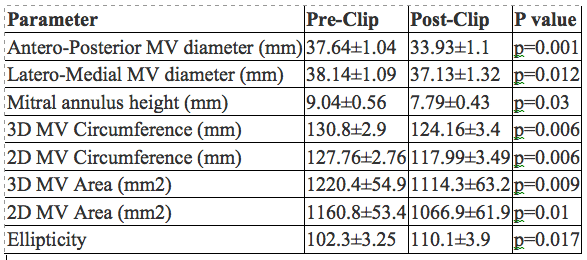
Acute Anatomic Changes after Transcatheter Mitral Valve Repair
2Area del Corazón, Instituto de Investigación Sanitaria del Principado de Asturias
Introduction: Transcatheter mitral valve repair (TMVR) is an alternative option for patients with severe and symptomatic functional or degenerative mitral regurgitation (MR) at high surgical risk. Acute effect of MitraClip® procedure on mitral valve (MV) annular geometry remains unclear. We sought to assess immediate effect of TMVR on MV annular geometry and to describe clinical outcomes after TMVR in a tertiary centre.
Material And Methods: Prospective inclusion of TVMR patients between October 2015 and January 2017. 3D reconstruction of MV annular geometry with transesophageal echocardiography was performed immediately before and after clip implantation. Data on clinical follow-up was recoded.
Results: We included 14 consecutive patients, mean age was 74.7+9.2 years, 21.4% were women. 78.6% had hypertension, 35.7% diabetes, 64.3% chronic kidney disease, 7.15% previous stroke. 78.6% were diagnosed of dilated cardiomyopathy (42.9% of ischemic etiology, 35.7% idiopathic) and 50% atrial fibrillation. 78.57% had moderate or severe pulmonary hypertension. Mean values of surgical risk scores were: Euroscore I 18.2%, Euroscore II 7.73% and STS 5.15%. MR was functional in 78.6% of patients. Significant reduction in MV diameters, MV 2D and 3D annular circumference and surface, and acute increase in MV ellipticity were observed (table 1).

Previous MR grade was III in 14.3% and IV in 85.7%, while after procedure was grade I-II in 93%. During follow-up (median 283 days, interquartile interval 182-378 days), only one patient died (7.13%).
Conclusions: After MitraClip® implantation in a high-risk population, we observed significant acute changes in MV geometry and anatomy using three and two-dimensional transesophageal echocardiography. MR grade was notably reduced and one year survival is high.

Powered by Eventact EMS